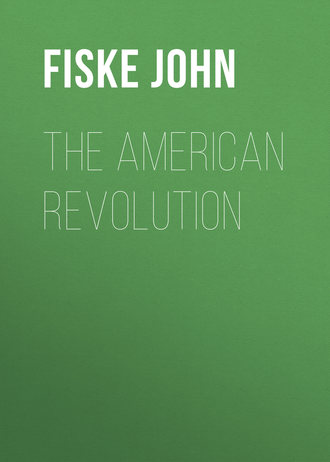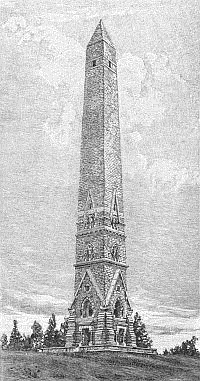 полная версия
полная версияThe American Revolution
7
[Of a family always prominent in Rhode Island, he had early come to be the most admired and respected citizen of the colony. His father, a narrow-minded Quaker, though rich in lands, mills, and iron forges, was adverse to education, and kept his son at work in the forges. But the son had an intense thirst for knowledge, and, without neglecting his duties, he bought books and became well versed in history, philosophy, and general literature.]
8
The first stage was the change from the solid red of the British ensign to the alternate red and white stripes, as seen in the flag on the right, which typified the thirteen confederated colonies. After allegiance to the British crown had been thrown off, the union of red St. George and white St. Andrew crosses upon the blue corner became inappropriate, and in June, 1777, Congress substituted the circle of thirteen white stars on a blue ground, to signify the rise of a new constellation of states.
9
Jonathan Trumbull, Governor of Connecticut, was a graduate of Harvard in 1737, in the same class with Hutchinson. Washington used to call him “Brother Jonathan.” He was father of John Trumbull, the famous painter.
10
This view is taken from the Hudson river, and shows Fort George at the extreme right. The street facing upon the river was Greenwich Street, from which the descent to the water was abrupt. The cliff-like look of the banks has since been destroyed by the addition of new land sloping gently down to the water level at West Street. The church most conspicuous in the picture is the old Trinity, which was burned in 1776.
11
This is a contemporary view of the road by which Howe advanced upon Sullivan’s rear.
12
I leave this as I wrote it in June, 1883. Since then another version of the facts has been suggested by W. L. Stone in Appleton’s Cyclopædia of American Biography. In this version, Mr. Jones sends a party of Indians under the half-breed Duluth to escort Miss McCrea to the camp, where they are to be married by Mr. Brudenell, the chaplain. It is to be quite a fine little wedding, and the Baroness Riedesel and Lady Harriet Ackland are to be among the spectators. Before Duluth reaches Mrs. McNeil’s house, the Wyandot Panther (here known by the name of a different beast, Le Loup) with his party attacks the house and carries off the two ladies. The Panther’s party meets Duluth’s near the spring. Duluth insists upon taking Jenny with him, and high words ensue between him and the Panther, until the latter, in a towering rage, draws his pistol and shoots the girl. This version, if correct, goes some way toward reconciling the legend with the observed facts.
13
This contemporary British caricature represents the new allies, “Noble Pair of Brothers,” George III. and an Indian chief, seated together at their cannibal banquet. It expresses the lively disgust with which the employment of Indians was regarded in England.
14
In the spring of 1776 Lee had written to Edward Rutledge: “By the eternal God! If you do not declare yourselves independent, you deserve to be slaves!” In several such letters Lee had fairly bellowed for independence.
15
Things seemed to be getting into somewhat the condition contemplated in the satirical print of “The Man in the Moon,” which appeared as frontispiece to a tract published in London in 1776, entitled “A Plea of the Colonies on the Charges brought against them by Lord Mansfield and others.” The Man in the Moon is George III. looking through a telescope held by his Tory chief justice, whose sleeve shows the Scotch plaid of Clan Murray. He looks upon a reversed and topsy-turvy world, in which New York (whose true latitude is nearly the same as that of Naples) appears farther north than London, and America is east of Europe. The American coast is covered with vast armies, and the whole British fleet is on its way thither, leaving England exposed to the attack of a French host gathered at Dunkirk. Meanwhile the Gallic cock crows lustily, and the sketchy outline of Great Britain indicates that the artist supposes the island “may be so far wasted before the year 1800, that people will hardly know where the nation resided that was once so formidable.” See Tracts 985, Harvard University Library.
16
“This episode appears to me the most criminal in the whole reign of George III., and in my own judgment it is as criminal as any of those acts which led Charles I. to the scaffold.” Lecky, History of England in the Eighteenth Century, vol. iv. p. 83.
17
As usual in such cases, there is a great diversity of testimony as to what was said. In my first edition I gave the familiar story of which there is a meagre version in Bancroft and a much fuller one in Irving: “What is the meaning of all this?” etc.; but I suspect that story is much too literary. It is not likely that any such conversation occurred at such a moment. A young sergeant, Jacob Morton, was standing close by when Washington met Lee. This Morton, who afterward became a major, was noted for accuracy and precision of statement. In 1840 he gave his account of the affair to Mr. Harrison Robertson, of Charlottesville, Virginia; and in 1895 Mr. Robertson kindly wrote out for me his recollection of that account. According to Morton, Washington simply shouted, “My God! General Lee, what are you about?” This has the earmark of truth. Another account, traceable to Lafayette and likewise probable, says that as Washington swept furiously past and away, he ejaculated with bitter emphasis, “Damned poltroon!”
18
Such was Steuben’s own testimony on the court-martial. Lee was so enraged by it as to make reflections upon Steuben which presently called forth a challenge from that gentleman. (Lee Papers, iii. 96, 253.) It is to be regretted that we have not the reply in which Lee declined the encounter. There is a reference to it in a letter from Alexander Hamilton to Baron von Steuben, a fortnight after the challenge: “I have read your letter to Lee with pleasure. It was conceived in terms which the offence merited, and, if he had any feeling, must have been felt by him. Considering the pointedness and severity of your expressions, his answer was certainly a very modest one, and proved that he had not a violent appetite for so close a tête-à-tête as you seemed disposed to insist upon. His evasions, if known to the world, would do him very little honour.” Upon what grounds Lee refused to fight with Steuben, it is hard to surmise; for within another week we find him engaged in a duel with Colonel Laurens, as will presently be mentioned in the text.
19
Washington’s Writings, ed. Ford, vii. 90.
20
“I never saw the General to so much advantage… A general rout, dismay, and disgrace would have attended the whole army in any other hands but his. By his own good sense and fortitude he turned the fate of the day… He did not hug himself at a distance, and leave an Arnold to win laurels for him; but by his own presence he brought order out of confusion, animated his troops, and led them to success." —Hamilton to Boudinot, 5 July, 1778. Observe the well-timed sneer at Gates. Boudinot answers, “The General I always revered and loved ever since I knew him, but in this instance he rose superior to himself. Every lip dwells on his praise, for even his pretended friends (for none dare to acknowledge themselves his enemies) are obliged to croak it forth." —Boudinot to Hamilton, 8 July, 1778.
21
He has been sometimes described incorrectly as a half-breed, and even as a son of Sir William Johnson. His father was a Mohawk, of the Wolf clan, and son of one of the five chiefs who visited the court of Queen Anne in 1710. The name is sometimes wrongly written “Brandt.” The Indian name is pronounced as if written “Thayendanauga,” with accent on penult. Brant was not a sachem. His eminence was personal, not official. See Morgan, League of the Iroquois, p. 103.
22
It has been shown that on this occasion Thayendanegea did what he could to restrain the ferocity of his savage followers. See Stone’s Life of Brant, i. 379-381. It has more lately been proved that Thayendanegea commanded only his own Mohawks at Cherry Valley, and the atrocities were committed chiefly by Senecas under the command of Sayenqueraghta. See Molly Brant’s letter in Hayden’s The Massacre of Wyoming, Wilkes-Barré, 1895, p. xxiv.
23
Cannon were wheeled on the solid ice from Staten Island to the city. See Stone’s Life of Brant, ii. 54.
24
In a paper read before the Maryland Historical Society. See, also, his Logan and Cresap, Albany, 1867. The story is well told by Mr. Theodore Roosevelt, in his admirable book, The Winning of the West, New York, 1889. Though I leave the present chapter mainly as it was written in 1883, I have, in revising it for publication, derived one or two valuable hints from Mr. Roosevelt’s work.
25
This point has been well elucidated by Mr. Roosevelt in his Winning of the West, vol. i. pp. 240, 306.
26
See my Critical Period of American History, chap. i.
27
“The conduct of the Americans upon this occasion was highly meritorious: for they would have been fully justified in putting the garrison to the sword: not one man of which was put to death but in fair combat.” Stedman’s History of the American War, London, 1794, vol. ii. p. 145. This remark seems to bear unconscious testimony to the somewhat higher degree of humanity which American civilization had reached as compared with civilization in Europe. According to the usage inherited from the so-called ages of chivalry, it was deemed proper to massacre a captured garrison as a “punishment” calculated to deter commanders from wasting lives in trying to defend indefensible places. In the thirteenth article of the international agreement proposed in the Brussels Conference of 1874, such slaughter is called “murder,” and is strictly prohibited; it would not now be tolerated by public opinion anywhere in Europe outside of Turkey. In our Revolutionary War the garrison of Fort Washington was threatened with slaughter by General Howe, but the threat was not carried out. (See above, vol. i. p. 230.) At the capture of Fort Griswold, Sept. 6, 1781, the massacre of the surrendered garrison has always been rightly regarded as a foul blot upon the British record. Mr. Lecky more than once recognizes the humanity of the Americans, and pronounces them superior in this respect to the British. (History of England in the Eighteenth Century, iv. 145, and elsewhere.) Care must be taken, however, in the interests of historic truth, not to press this opinion too far. A great deal of fustian has been written about the “barbarities” of the British soldiers in the Revolutionary War. John Adams compared those honourable and kindly gentlemen, the brothers Howe, with such wretches as Borgia and Alva, and suggested that “medals in gold, silver, and copper ought to be struck in commemoration of the shocking cruelties, the brutal barbarities, and the diabolical impieties of this war; and these should be contrasted with the kindness, tenderness, humanity, and philanthropy which have marked the conduct of Americans toward their prisoners.” (Familiar Letters of John Adams and his Wife, p. 266.) The spirit of this quotation pervades the late George Bancroft’s narrative of the Revolution, and fills it with a carping animosity that is simply silly. In point of fact there was no strongly marked difference between British and Americans in respect of humanity. Much has been said about the horrors of the British prison-ships in New York harbour and elsewhere (see Greene’s Historical View, p. 351); but the horrors of the old Newgate prison near Granby, in my native state of Connecticut, were even worse (see Phelps’s History of the Newgate Prison), and the prisons of Massachusetts were not much better. Honest men unable to pay their debts were thrown into these frightful dungeons and treated as brutally as ever the British treated their prisoners of war.
Blame has been deservedly bestowed upon the British for their employment of Indian auxiliaries; but Americans must to some extent share the blame, for early in 1775, before the bloodshed at Lexington, the Provincial Congress of Massachusetts enlisted Stockbridge Indians as minute-men, and tried to prevail upon the Six Nations “to take an active part in this glorious cause.” Indians served on the American side at the battles of Long Island and White Plains (New York Colonial Documents, viii. 740; Jones’s Annals of Oneida County, p. 854; Winsor, Narr. and Crit. Hist. vi. 612-618). In a well-known passage of the Declaration of Independence the king is arraigned because “he has endeavoured to bring on the inhabitants of our frontiers the merciless Indian savages, whose known rule of warfare is an undistinguished destruction of all ages, sexes, and conditions.” The taint of hypocrisy here is revealed by the fact that Congress had on June 3 authorized Washington to employ 2,000 Indians in Canada; and on July 8 it further empowered him to enlist the tribes in eastern Maine and Nova Scotia. These orders were in pursuance of a resolve of May 25, that “it is highly expedient to engage the Indians in the service of the United Colonies.” (Secret Journals of Congress, p. 44; cf. Washington’s Writings, ed. Ford, iv. 140, 154, 168.) Washington approved of this hiring of Indians. On the whole, as so often happens, we held up our hands in holy horror at other people for doing what we did not scruple to do ourselves.
Among the articles adopted at the Brussels Conference of 1874 was one to the effect that “the population of an occupied territory cannot be compelled to take part in military operations against their own country, nor to swear allegiance to the enemy’s power.” (Farrer, Military Manners and Customs, p. 12.) No such rule was recognized a century ago. In South Carolina the British commanders shot as deserters persons captured in fight after having once accepted British protection. The execution of Col. Isaac Hayne, an eminent citizen, under peculiarly aggravating circumstances, by order of Lord Rawdon, called forth intense indignation. But it should not be forgotten that Greene also, on several occasions, shot as deserters persons found in the enemy’s ranks after serving in his own. Such was the military usage at that time.
A good many of the charges of cruelty, alleged on either side, must be taken with allowances for gross exaggeration. For example, at Concord, April 19, 1775, a farmer’s boy, in combat with a wounded soldier, struck him on the head with a hatchet and killed him. This incident, as magnified by the British, gave rise to the statement that the Americans mutilated and scalped the wounded soldiers lying on the road; a statement which is still sometimes repeated, although it was long ago proved to be false.
On the whole, while I agree with Mr. Lecky that the Americans behaved with more humanity than their antagonists, it does not appear that the difference was a wide one. To the credit of both sides it may be said that there was less barbarity than was usual in European wars before the nineteenth century.
28
The first commander-in-chief of the United States navy was Ezekiel Hopkins, of Rhode Island, appointed by Congress in December, 1775. His rank was intended to correspond in the navy with that held by Washington in the army. In the papers of the time he is often styled “admiral,” but among seamen he was commonly known as “commodore.” The officers next below him were captains. In February, 1776, Hopkins got out to sea with a small fleet; in April, with two sloops-of-war and three small brigs, he attacked the British sloop Glasgow 20, and failed to take her. His failure was visited with severe and perhaps excessive condemnation; in the following October, Congress passed a vote of censure on him, and in January, 1777, dismissed him from the service. For the rest of the war no commander-in-chief of the navy was appointed.
One of Hopkins’s vessels, the brig Lexington 14, was commanded by John Barry, a native of Wexford county, Ireland, who had long dwelt in Philadelphia. In April, 1776, a few days after Hopkins’s failure, the Lexington met the British tender Edward off the capes of Virginia, and captured her after an hour’s fight. This was the first capture of a British warship by an American. Barry served with distinction through the war and died at the head of the navy in 1803.
29
In March, 1780, the navy of the United States consisted of the following vessels: —
America 74, Capt. John Barry, on the stocks at Portsmouth, N. H.
Confederacy 36, Capt. Seth Harding, refitting at Martinico.
Bourbon 36, Capt. Thomas Read, on the stocks in Connecticut.
Alliance 32, Capt. Paul Jones, in France.
Trumbull 28, Capt. James Nicholson, ready for sea in Connecticut.
Deane 28, Capt. Samuel Nicholson, on a cruise.
Providence 28, Capt. Abraham

Ranger 18, Capt. S. Sampson,
Saratoga 18, Capt. J. Young, on the stocks at Philadelphia.
See Sparks MSS. xlix. vol. iii. in Harvard University Library.
30
Richard Paton’s picture of this sea-fight, of which a photogravure is here given, departs somewhat from the strict truth of history, as is apt to be the case with historical pictures. The Alliance is represented in the act of delivering her impartial volley into the stern of the Serapis and the bow of the Bon Homme Richard, which occurred soon after ten o’clock. At the same time the mainmast of the Serapis is represented as overboard, whereas it did not fall until the ships were separated after the surrender, as late as half past eleven. Apart from this inaccuracy, the general conception of the picture is admirable. The engraving, published in 1780, was dedicated to Sir Richard Pearson, the captain of the Serapis, who was deservedly knighted for his heroic resistance, which saved the Baltic fleet, although he was worsted in the fight. There is a tradition that Paul Jones, on hearing of the honour conferred upon Pearson, good-naturedly observed, “If I ever meet him again I’ll make a lord of him.”
31
Agricultural communities lack the right kind of experience for understanding the real nature of money, and farmers are peculiarly subject to financial delusions. This has been illustrated again and again in American history, with lamentable consequences, from the Massachusetts issue of “paper money” in 1690 down to the drivelling schemes of the silver lunatics at the present time.
32
The story of his attempt to enter the service of Luzerne, the French minister who succeeded Gerard, rests upon insufficient authority.
33
The charge against Mrs. Arnold, in Parton’s Life of Burr, i. 126, is conclusively refuted by Sabine, in his Loyalists of the American Revolution, i. 172-178. I think there can be no doubt that Burr lied.
34
The version of the reprimand given by Marbois, however, is somewhat apocryphal.
35
To a gentleman, like Clinton, such a proposal was a gross insult, to which the only fitting answer would have been, “What do you take me for?” The scheme was highly discreditable to all concerned, and if Washington was one of these, it must be pronounced a blot upon his record. The only explanation would be that the “vague sense of injustice” mentioned below must have been felt by him so keenly as to warp for the moment his moral judgment.
36
In 1782, the British government granted him a pension of £1,000 a year for his lifetime and that of his wife. Arnold died in 1801, Mrs. Arnold in 1804.
37
As Lecky well says, “there is something inexpressibly touching in the tender affection and the undeviating admiration for her husband, which she retained through all the vicissitudes of his dark and troubled life.” Hist. of England in the Eighteenth Century, iv. 136. Her affection seems to have been repaid with perfect loyalty on Arnold’s part. His domestic life seems to have been above reproach, in which respect he presents a strong contrast to such utterly depraved wretches as Charles Lee and Aaron Burr.
38

THE SARATOGA MONUMENT
This is the most suitable place for making mention of the Saratoga monument, which was erected in 1883, but is not yet completed. The obelisk, 155 feet in height, stands upon a bluff about 300 feet above the Hudson river, and just south of the road from Schuylerville to Saratoga Springs. The view here given is taken from the southeast. The great pointed-arch niches in the base, just over the doorways, are occupied by bronze statues of heroic size. Of these it was necessary that one should be the unworthy Gates, who commanded the army and received Burgoyne’s surrender. The second and third are obviously Schuyler and Morgan. The fourth niche is vacant. The place belongs to Arnold, who was especially the hero of Saratoga. But for Arnold, the relieving army of St. Leger might have come down the Mohawk valley. But for Arnold, the 19th of September would have seen Gates’s position turned at Bemis Heights. But for Arnold the victory of October 7th would probably have been indecisive, so that time would have been allowed for Clinton to come up the Hudson. In commemorating Saratoga, to leave Arnold unnoticed would be impossible. He has therefore his niche, but it is vacant. When the monument is completed, the names of the four generals are to be inscribed below their niches, and then the empty niche will speak as eloquently as the black veil that in the long series of portraits of Venetian doges covers the place of Marino Faliero.
In the view here given, the empty niche is seen on the left. The niche on the right, or east, contains (on almost too small a scale to be here visible) the statue of Schuyler, with folded arms, gazing upon the field of surrender where he ought to have presided. On the north side stands Gates with a spy-glass, as in the final battle; while Arnold was winning victory for him, he stood on Bemis Heights to watch what he supposed would be the retreat of the Americans! On the west side Morgan is in the attitude of ordering his sharpshooter Tim Murphy to fire upon General Fraser. These poses were suggested by Colonel William Leete Stone, secretary of the Saratoga Monument Association, to whom, indeed, the monument owes its existence.
The interior of the monument is finely decorated with bas-reliefs of scenes in the Burgoyne campaign.
39
It was the sons of these invincible men who vanquished Wellington’s veterans in the brief but acute agony at New Orleans; it was their grandsons and great-grandsons who came so near vanquishing Grant at Shiloh and Rosecrans at Stone River.
40
“History, perhaps, does not furnish an instance [he means another instance] of a battle gained under all the disadvantages which the British troops … had to contend against at Guilford. Nor is there, perhaps, on the records of history, an instance of a battle fought with more determined perseverance than was shown by the British troops on that memorable day.” Stedman, History of the American War, London, 1794, ii. 347.
41
It is interesting to contrast with the movements of Cornwallis those of an eminent general in more recent times. Early in 1865 General Sherman was at Columbia, on the Congaree river, about thirty miles southwest from Camden, and the difficult task before him was, without any secure base of operations nearer than Savannah, to push the Confederate forces northward to a decisive defeat in North Carolina. With this end in view, Sherman feigned to be aiming at Charlotte, while in reality he moved the bulk of his army northeasterly across the Pedee and Cape Fear rivers to Goldsborough, near the coast, where he established a new and secure base of operations. The battle of Bentonville, fought just before Sherman reached this base, was the unsuccessful attempt of his skilful antagonist, Joseph Johnston, to prevent his reaching it. Sherman’s march northwestward from his new base was well secured, and Johnston’s surrender near Hillsborough was a natural sequel. But – as my friend, Mr. John Codman Ropes, in a letter to me once pointed out – "had Sherman pursued his march from Columbia to Charlotte, and thence until he had met and fought Johnston, the result of the inevitable losses of the battle, leaving the question of victory aside, might have been such as to compel a retreat to Savannah.”









